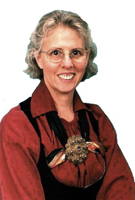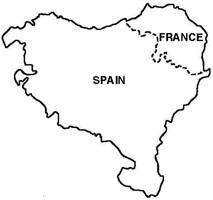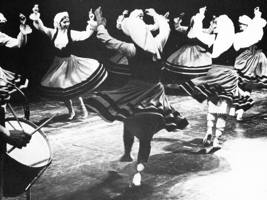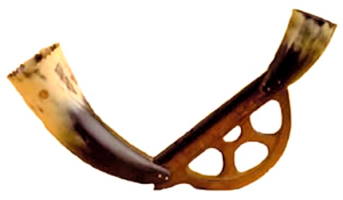
|
The Society of Folk Dance Historians (SFDH)
The Basque Jota
[
Home |
About |
Encyclopedia | CLICK AN IMAGE TO ENLARGE |

|
 Basque dancing brings several images to mind: the Souletine Masquerade containing the famous wine glass dance, the many men's set dances with balletic type steps similar to the English Morris dances, and the Jota, a lively dance that is seen at almost every gathering of Basque people. The Jota, by virtue of its presence at most gatherings, seems to be the national dance of the Basque people. Even though most Basque dances are danced by men, Basques of all ages, all vocations, men and women, know and participate in the Jota.
Basque dancing brings several images to mind: the Souletine Masquerade containing the famous wine glass dance, the many men's set dances with balletic type steps similar to the English Morris dances, and the Jota, a lively dance that is seen at almost every gathering of Basque people. The Jota, by virtue of its presence at most gatherings, seems to be the national dance of the Basque people. Even though most Basque dances are danced by men, Basques of all ages, all vocations, men and women, know and participate in the Jota.
There is no agreed origin of the Basque Jota. Some believe that the Jota came from Southeast Spain via Aragón more than two hundred years ago. Others feel it came via Castilla, and still others feel it originated within the Basque provinces and then later on, adapted elements from neighboring regions.
Jotas today are composed of a suite or couplet of two dances, the Fandango and Ariñ-Ariñ (pronounced "Ah-reen Yah-reen" with a trilled "R"). These dances also are known by several other names. A few of those most widely used are Baile al Suelto (loose dance) referring to the fact that there is no bodily contact amongst the dancers, Orripiko, and Porrusalda. Baile al Suelto or Jota are terms that apply to Basque dances. Baile Agarrado, attached dances or dances with some form of bodily contact, is the term used to refer to foreign dances – an example is the Waltz.

The Fandango is usually in 3/8 or 3/4 meter and the Ariñ-Ariñ in 2/4 meter, with the accent falling on the first beat of the measure in both dances. The lengths of the Fandango and Ariñ-Ariñ throughout the provinces vary. In Navarra, the Fandango is usually quite long in comparison to the Ariñ-Ariñ, with the Ariñ-Ariñ not much more than a tag or coda stuck onto the Fandango. In Alava, the Fandango and Ariñ-Ariñ are approximately the same length, while in the provinces of Viscaya and Guipuzcoa, the Fandango is shorter than the Ariñ-Ariñ.
The formation and number of people dancing a Jota varies. In competitions, Jotas are danced in couples with partners facing one another. In performances, Jotas tend to be danced also in couple formations, but when danced socially and at festivals, they are danced in small and large circles of people, all facing the center.
A Jota has several different types of patterns. Often, each dance begins with a stationary pattern. In stationary patterns, the dancers move in place and generally do not change their facing. Another type of pattern is one that moves from side to side. Here the dancers tend to change their bodies, changing to face the direction to which they are moving. The last general type of pattern is one that turns that may be full or partial. Most of the patterns alternate from side to side, beginning with one foot or in one direction, that is repeated symmetrically with the other foot to the other side. Also, the sequence of patterns usually ends with some sort of a turn. If there are sixteen measures to each dance phrase; usually the last four would include a turn of some sort. This tends to be true for all three of the above pattern types. An example dance phrase might be a stationary pattern for four measures, this to be repeated twice for eight measures, then a four-measure turn ending the phrase.
A notable characteristic of Jotas is that the dancer's torso is held erect, strong, and does not move about. Some feel that this erect carriage of the torso represents Basque pride. Jotas are dance with the arms held upright, often with fingers snapping in time to the music. The upper portion of the arm is approximately held horizontal to the ground and the forearm is held vertical. In competition Jotas, this arm formation tends to be the norm, but when the occasion for dancing is more social and relaxed, the arms relax, becoming a sort of "W" shape. Socially, Jotas are danced in a somewhat relaxed position on the balls of the feet, with competition Jotas danced in full ball position.
 In the Basque provinces, Jotas are almost exclusively danced to live music. Up until recently, Jotas were often danced to the music of Basque musical instruments. A "txistulari," a single person who plays with his left hand a "txistu" (a three-holed flute) and beats the rhythm with the right hand on a "tamboril" (a snare-type drum) suspended from the crook of the left elbow. The "triki-trixa" is an accordionist and singer/tambourine combination. Jota music also is played by an "Albokari" and a singer/tambourine combination. The "Alboka" (a double-reeded bagless bagpipe) sounds similar to and is played like the double-reed instruments of Eastern Europe – the "zurna" or "zurla."
In the Basque provinces, Jotas are almost exclusively danced to live music. Up until recently, Jotas were often danced to the music of Basque musical instruments. A "txistulari," a single person who plays with his left hand a "txistu" (a three-holed flute) and beats the rhythm with the right hand on a "tamboril" (a snare-type drum) suspended from the crook of the left elbow. The "triki-trixa" is an accordionist and singer/tambourine combination. Jota music also is played by an "Albokari" and a singer/tambourine combination. The "Alboka" (a double-reeded bagless bagpipe) sounds similar to and is played like the double-reed instruments of Eastern Europe – the "zurna" or "zurla."
Jotas are danced at most fiestas of the Basque people, including fiestas on patron saints' days and fiestas that celebrate national historical events. During these events, Jotas are danced in several different contexts. They are danced in conjunction with some rituals. There are Jota dance competitions. Dance performances include Jotas often as the finale of the exhibition. Finally, there is the social dancing that includes "romerias" (open-air dances), street dancing, and Day of the Dancer celebrations where anyone and everyone participates.
The Jota is one of five or six different dances done on these social occasions. Often, these social dance events are in the late evening after supper and have some sort of live music combination, usually amplified. The dances found most frequently at these events are the Jota, Pasadoble (or two-step), Waltz, Polka, Schottische, and Jautziak. These dances might be alternated through the evening and some of the modern rock-type dances may also be included. It is at these social occasions that Jotas are learned or transmitted throughout the culture. With everyone dancing and people gathering to form a larger geographical area than just the village or town of the event, there is a lot of sharing of styles and steps. Children barely old enough to walk, stand, jump, and move their arms in time to the music. This is done with the encouragement of family and friends. It seems clear why everyone learns and dances the Jota from such an early age with such positive reinforcement.
Costumes are worn in performances, competitions, and many people also wear them during fiestas. For the women, usually one of the two principal costume types will be worn – the "casera" or the "hilandera." These costumes are generally worn with "abarcas," a leather shoe somewhat similar to the "opanke", knee socks, and black cords that lace up the calf. White bloomers and slips are worn under either costume. The "casera" costume has a gathered skirt, shirt, apron, shawl, and head scarf. The shirt, skirt, and apron tend to be in black or navy blue, and often are of polka-dotted fabrics, with white or white polka-dotted shawls and head scarves. The "hilandera" costume has a red or green felt skirt, circular shaped, with one or more bands of black ribbon on the bottom third, a white blouse, black apron and bodice, and a white head scarf.
For the men, one costume has "abarcas" and white socks like the women, and pants often grey or blue, a white shirt, a red or blue sash at the waist, a "bluzon" (an overshirt somewhat like a French painter's smock), a neckerchief, and a black or navy beret. Another costume for the men is sometimes referred to a "milkman outfit" here in America. It has white pants and shirt, with a red sash at the waist, a red beret and neckerchief, and a white pair of "alpargatas" (rope-soled shoes) tied with a red ribbon.
The Basque people seem to be a dancing people. Dance is a major form of their cultural expression what we as outsiders look at and call Basque. Their dance is not limited to persons of a special society, group, or age. Everyone seems to dance – and they all dance the Jota.
DOCUMENTS
- Basque Musical Instruments, an article.
- Basques, a culture.
- Basques and their Dances, an article.
Used with permission of the author.
Printed in Folk Dance Scene, December 1978.
This page © 2018 by Ron Houston.
Please do not copy any part of this page without including this copyright notice.
Please do not copy small portions out of context.
Please do not copy large portions without permission from Ron Houston.